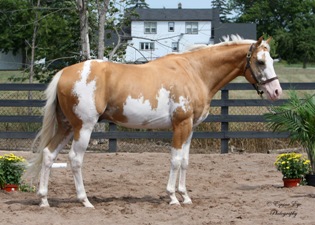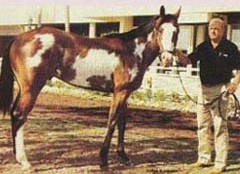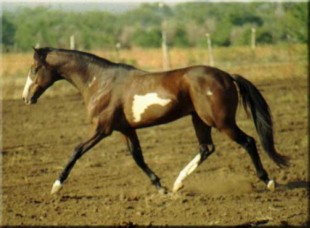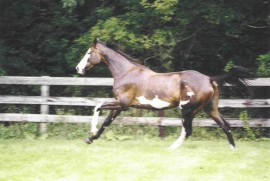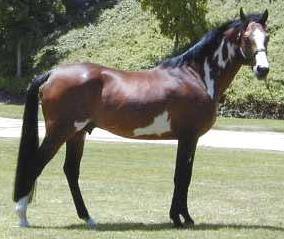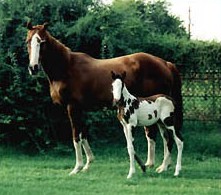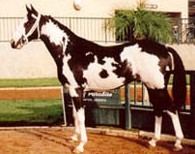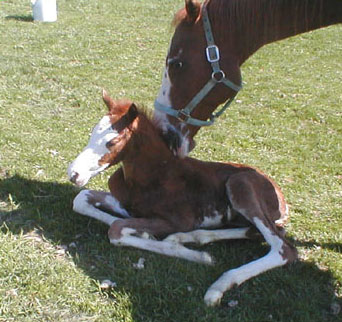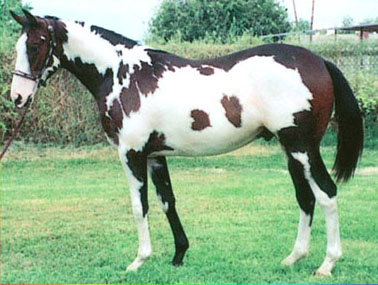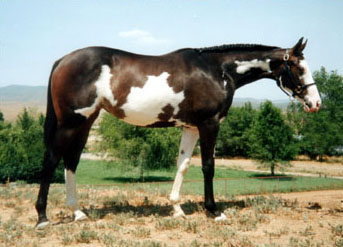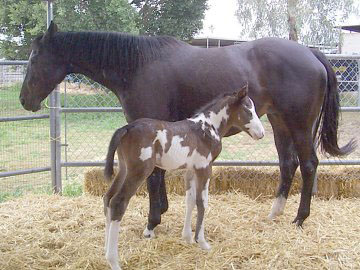Four pinto patterns exist in the Thoroughbred gene pool---dominant white, sabino, frame overo, and splash white. Sabino is quite common and can be found in virtually all TBs, while dominant white, frame, and splash are quite rare, and have only been produced by a handful of families.
As I've explained on my main horse color pages, pinto patterns tend to range in expression from a minimum of white to an all white individual to everything in between. This page is primarily devoted to more extremely marked dominant white and sabino TBs and pretty much any frame or splash TB I can find. :-)
|
Dominant White (DW): It was long thought that the white Thoroughbreds that cropped up in the breed were the result of the sabino gene, but the recent discovery of the dominant white gene has proved that most of the known white TB families are in fact dominant whites. Given that that color is the result of a randon mutation, its tendency to crop up from ordinary-looking parents finally makes sense. Several families of loudly marked TBs have been tested and confirmed as dominant whites, notably those of KY Colonel, Puchilingui, and Shirayukihime. I haven't been able to turn up any photos of KY Colonel, but he was described as being a chestnut horse with high white stockings and a belly spot, a description that would fit a moderately expressed dominant white. He sired two dominant white horses, War Colors and White Beauty. War Colors was registered as a roan, and was therefore likely a white ticked, moderately expressed DW. War Colors died young and did not produce any offspring. White Beauty, on the other hand, was all white (or near enough) and is the well-spring of a number of well-known DW Thoroughbreds through her daughter World O'Beauty, her daughter Precious Beauty, and her daughter Patchen Beauty. PB has produced 5 DW foals to date, and several of them are following suit in the breeding shed already. |
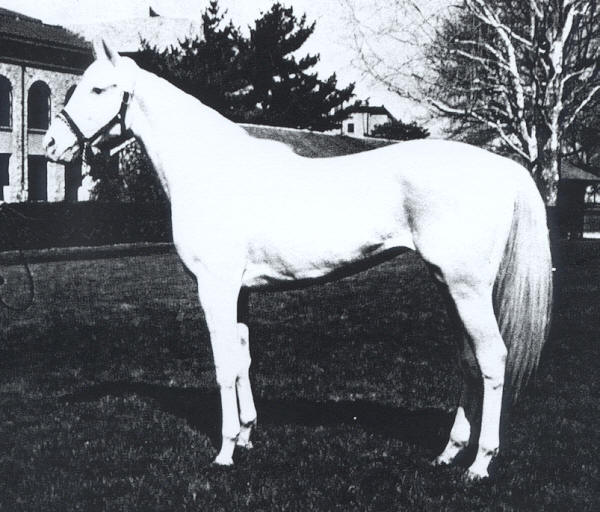 White Beauty |
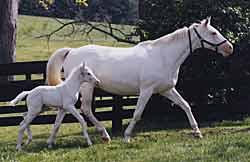 Precious Beauty with Patchen Beauty as a foal |
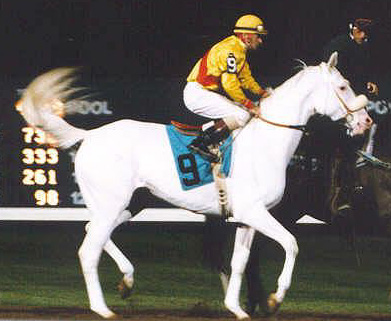 Patchen Beauty on the track |
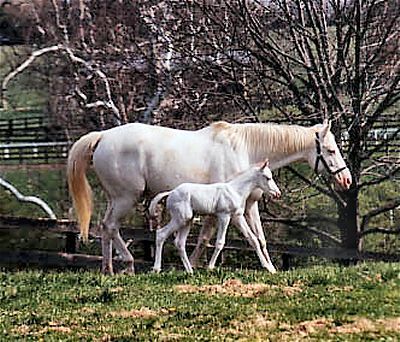 Patchen Beauty with The White Fox as a foal |
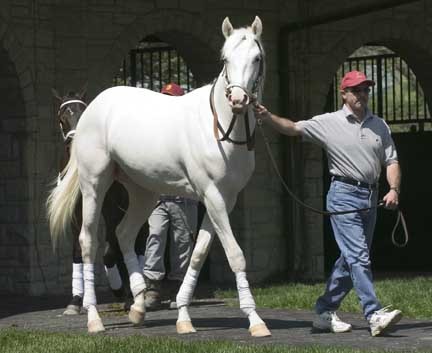 The White Fox |
|
Puchilingui was a very popular sire of colorful Thoroughbreds, and his best known son Sato is carrying on his sire line. Puchi produced both moderately and maximally expressed DWs. |
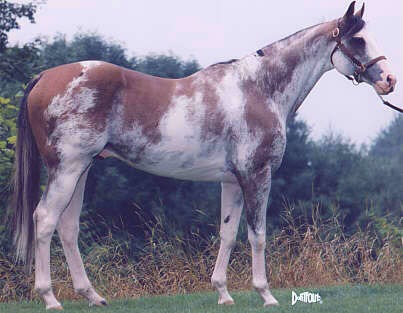 Puchilingui |
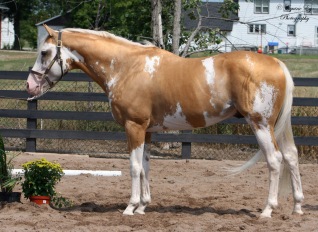 Sato's other side |
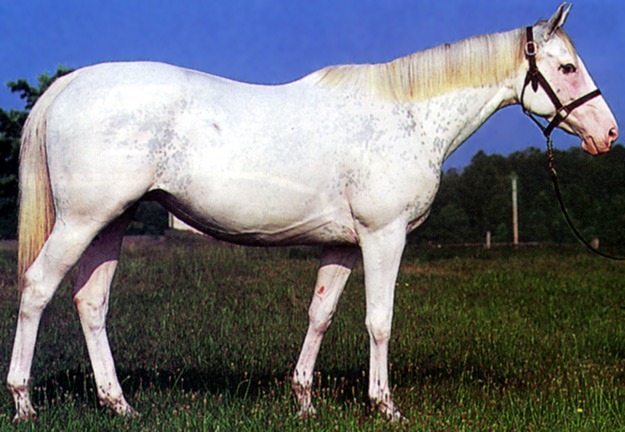 Artic Color, a well-known daughter of Puchilingui |
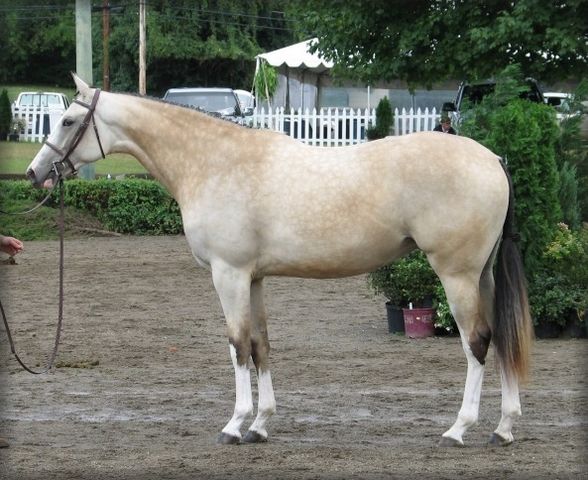 Faux Finish, a champion granddaughter of Puchilingui through her dam Puchi Trap. She may be a very moderately marked DW or she may be a sabino. Sabino and DW have likely been mixed, so it's hard to say without a DNA test. (Owned by True Colours Farm) |
|
Shirayukihime, the daughter of the true black stallion Sunday Silence and a bay mare, Wave Wind, was quite a surprise to her breeders and is a terrific example of how dominant white can crop up from the most mundanely colored pairings. Five of her six foals (as of 2011) are white including the immensely popular Yukichan. |
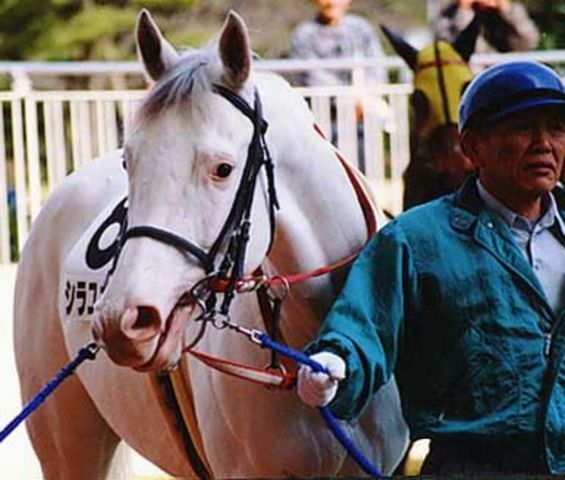 Shirayukihime (1996 w m Sunday Silence x Wave Wind, Topsider) |
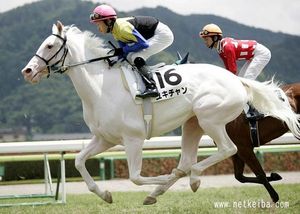 Yukichan (2005 w m Kurofune x Shirayukihime) |
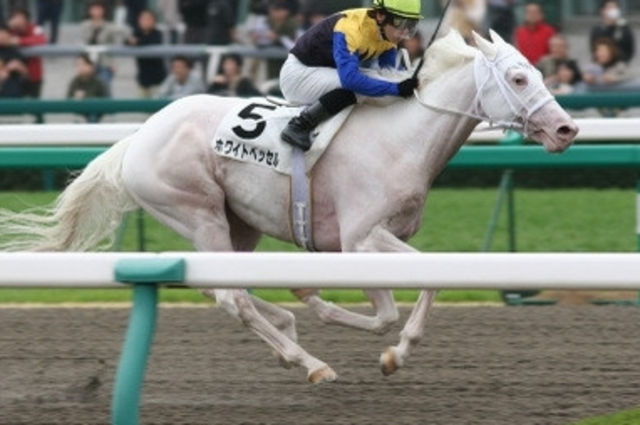 White Vessel (2004 w h Kurofune x Shirayukihime) |
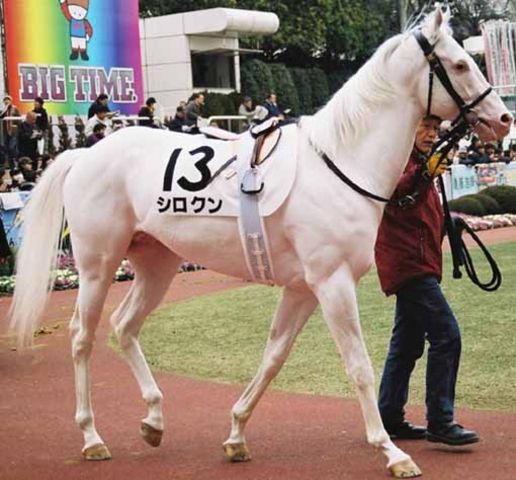 Shirokun (w h Black Hawk x Shirayukihime) |
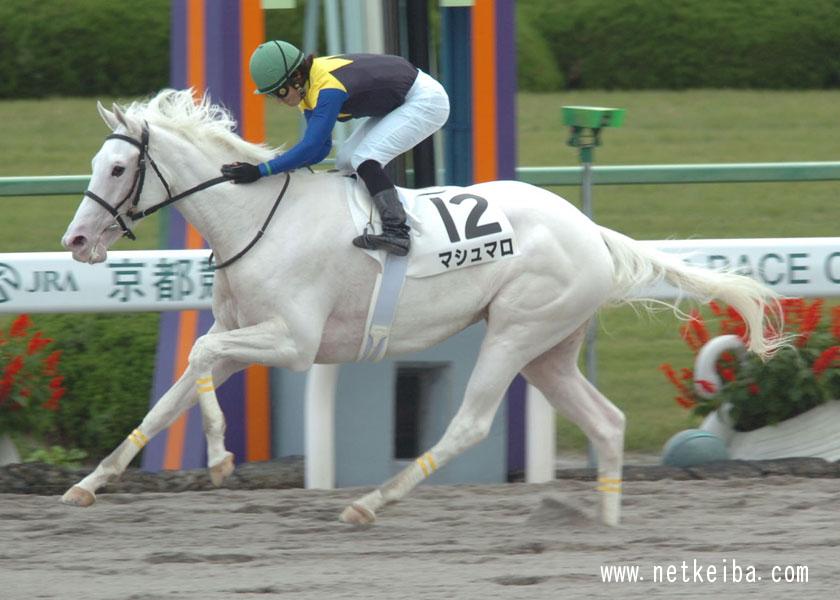 Marshmallow (2009 w h Kurofune x Shirayukihime) |
| The mare Turf Club is also an excellent example of the randomness of the dominant white mutation. She is by Trust N Luck, a chestnut stallion with very little white, out of Deebrand, a bay mare, again with not much white. Turf Club herself is an excellent example of the mottled mix of base color (in this case, chestnut) and white that many dominant white horses exhibit. |
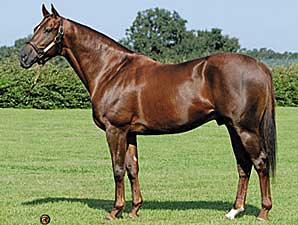 Trust N Luck, an ordinary chestnut (photo by Louise Reinagel) |
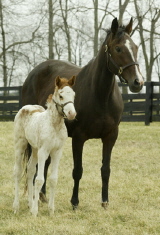 Deebrand, and ordinary bay with Turf Club as a foal (photo by Matt Goins) |
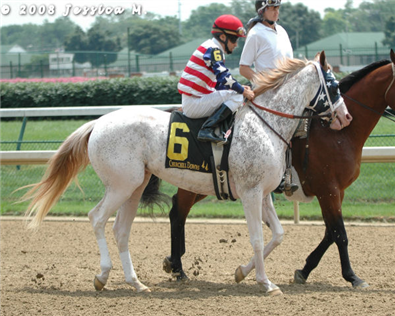 Turf Club as a 3 year-old (photo by Jessica Morgan) |
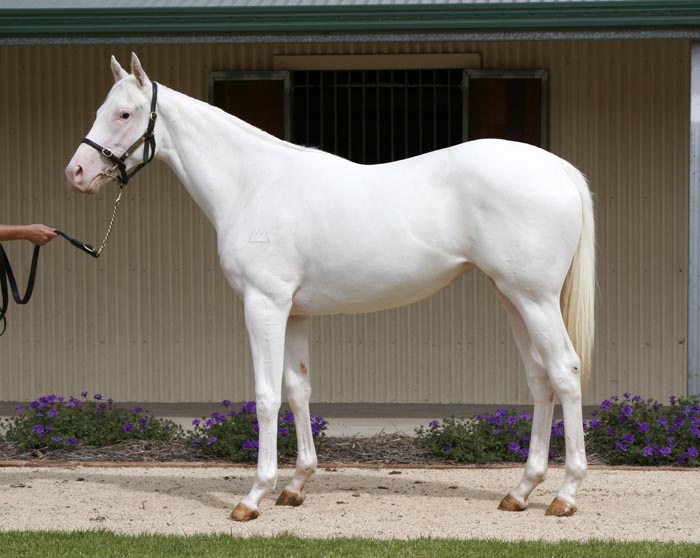 |
Though they have not all been DNA tested, it is likely that the other white Thoroughbreds are dominant whites rather than maximally expressed sabinos. Airdrie Apache's dam Not Quite White is almost certainly a dominant white, and it is likely that Airdrie Apache himself and his offspring are as well, such as Allamystique, Arctic White, Painting Freedom, etc. Other likely dominant whites include Our White Lady, The Bride, and The Opera House (pictured at left), among others. As of 2011, there are less than 150 white Thoroughbreds registered worldwide, but with the explosion in popularity of colorful TBs in just the last 10 years, I imagine that number will climb steadily in years to come. |
| Sabino: Under construction..... Timely Roberto, and Spot Pocket. |
|
Frame Overo: Frame is known to exist in three TB families so far. If you know of more, please let me know! Unlike sabino, frame is very rare in TBs, and it's origins in the breed are not really known. The only frame overo TBs I know of have cropped up in the last 20 years. Because they are all the product of fairly obscure breeding, there is some thought that there may be a dose or two of non-TB blood lurking somewhere, but no one really knows. Regardless, they are papered TBs and the breed is definitely the richer for it. The first frames I know of are Tri Chrome (1991) and Blue Eyed Streaker (1993), both by Blue Gazi, and the mare Fillipas Puzzle (1993) by Great Deal. All three horses exhibit classic frame overo patterns, and I suspect they all carry sabino as well. Tri Chrome unfortunately was euthanized at a young age after being kicked in the paddock before a race. Blue Eyed Streaker currently stands at Echo Hill Farm in KY. (I would love to see photos of Blue Gazi if anyone knows of any!) And Fillipas Puzzle is a puzzle without a doubt. Her whereabouts are unknown, and she has no known progeny. |
|
Tri Chrome (Blue Gazi x Miss Joslin, Reward Lloyd) |
Blue Eyed Streaker (Blue Gazi x Bev's Girl, by Gage Line) |
Fillipas Puzzle (Great Deal x Phillipes Doll, by My Phillipe) |
|
Thankfully, the other frame overo TB family is more prolific. Oddly enough, it stems from the pairing of two "half" siblings, Pesty Axe and Torchy's Rainbow, both by Give Em The Axe. They produced two foals, Nite Spot in 1985 and Patchy Lassy in 1989. Nite Spot is a boldly marked bay frame overo + sabino, and his sister is a chestnut with a big blaze and tall stockings. Phenotypically, she only looks sabino, but clearly she is a minimally expressed frame as well. |
|
Nite Spot stands at Gestüt Falkenhorst in Germany. I'm not sure how any foals he has produced, but very few of them are here in the US. |
*Photo coming soon.* Spot, Nite Spot's only TB son standing in the US. He is a new stallion and minimally marked, but has apparantly produced colorful foals from 2 solid colored mares. He stands at Hillrise Farm in PA. (Photo by Hillrise Farm) |
| Patchy Lassy has produced several frame overo + sabino foals from different stallions, the best known being full-brothers Racey Remarque (1997) and Ellusive Quest (2000). She is also the dam of Red Hot Remarque (1999) by Broadway's Top Gun and Regal Regalia (2003) by C Spot Go. (All pictures below are by Nancy McEachern, DVM of Color World Ranch.) |
|
Patchy Lassy in 2000 with Ellusive Quest. She and her sons are bred and owned by Color World Ranch. |
The incredible Racey Remarque. Talk about a beautiful pattern! |
|
Regal Regalia pictured here with his dam in 2003. From the few pictures I've seen, RR's markings appear to be classic sabino, but I would wager that he has minimally expressed frame overo as well, just like his dam. |
Ellusive Quest as a young horse---what a pattern! He's my favorite of Patchy Lassy's foals. Not only is his pattern gorgeous, but he's been producing some beautifully marked frame overo + sabino foals as well. Go to the Color World Ranch website and click on Foals to see some of his colorful offspring. |
|
This lovely gal is Quit Starring, the 2002 daughter of Racey Remarque and She's Got a Look, by Big Leaguer. |
This lovely frame overo colt is by Ellusive Quest out of Regal Bounty, by Pirate's Bounty. Both mare and foal are owned by Colorworld Ranch. |
Still under construction.... :-)
